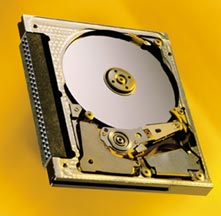[ The PC Guide | Systems and Components Reference Guide | Hard Disk Drives | Construction and Operation of the Hard Disk | Hard Disk Form Factors ]
CompactFlash Form Factor
In much the same way that the need for expansion capabilities in laptops led to the creation of the PCMCIA and PC Card devices, a consortium of electronics and computer industry companies in 1995 formed the CompactFlash Association to promote a new form factor called, of course, CompactFlash (abbreviated CF or CF+). This form factor is similar to the PC Card form factor, but amazingly enough, even smaller. CF cards are intended to be used not in laptop PCs but smaller electronic devices such as hand-held computers, digital cameras and communications devices (including cellular phones).
Unlike the PC Card standard, which is used for a wide variety of devices, CompactFlash is primarily designed around permanent storage. The "flash" in "CompactFlash" is from the primary technology used in these cards: flash memory. Flash memory is really electrically-erasable read-only memory, typically used in regular PCs only for holding the motherboard's BIOS code. The word "flash" refers to the ability to write and erase these ROMs electrically. Much the way you can "flash" your motherboard BIOS to update it, these flash memory storage cards have controllers in them that do this as part of their normal operation. Unlike regular memory, flash memory is of course non-volatile and retained when the power is removed.
The intention of the CompactFlash form factor was to allow consumer electronic devices to use these CompactFlash cards for their equivalent of a hard disk. Since the flash memory is not volatile, it does perform the same general function as a hard disk. Like PCMCIA devices, variants of the form factor were developed, differing only in thickness; the thicker cards provide more space to pack in additional flash memory chips for greater capacity. Here are the dimensions of the two types of CompactFlash cards:
Form Factor |
Width (in) |
Depth (in) |
Height (in/mm) |
Application |
CF+ Type I |
1.69 |
1.42 |
0.13 / 3.3 |
Smaller-capacity flash cards for digital cameras, hand-held computers and consumer electronics; not used for hard disks (yet) |
CF+ Type II |
1.69 |
1.42 |
0.20 / 5.0 |
Larger-capacity flash cards and hard disks for digital cameras, hand-held computers and consumer electronics |
As you can see, the CF form factors are very small: so small that they were probably never designed with the thought that anyone would make a true hard disk using them. The engineers at IBM however had a different idea! In 1999, while the makers of regular flash memory cards were struggling to reach 64 MB capacity, IBM introduced the Microdrive, a true hard disk that fits into the small confines of the CF form factor. The original Microdrive was available in either 170 MB or 340 MB capacities, which is pretty impressive considering that the drive uses a single 1" platter... even more impressive is the new Microdrive released in 2000 with a whopping 1 GB capacity! The Microdrive uses the CF Type II format, which is 5.0 mm thick. No current hard disks are made for the even smaller Type I size (only 3.3 mm thick) but I have heard rumors that at least one company is working on it, and I'd be surprised if IBM themselves didn't have something brewing in this regard also. Pretty cool.
|
IBM's amazing Microdrive. |
Image � IBM Corporation |
Smaller drives generally have less performance than full-sized ones and the Microdrive is no exception; it certainly doesn't compete with the newest 2.5" or 3.5" form factor drives for performance (though in many ways it is superior to flash memory chips). For its size it is certainly no slouch, though: it has a 3,600 RPM spindle speed, and very decent maximum areal density of as much as 15.2 Gbits/in2. (The original generation actually used a faster 4,500 RPM spindle; this was probably lowered to reduce power consumption and heat, both very serious issues for this form factor... however, the first Microdrives also had only one-third the areal density of the 1 GB model.) The extremely small size of the drive allows it to spin up to full speed in only half a second, a fraction of the time required by most large drives. This lets the Microdrive power down often when idle to save power, an essential feature for devices that use small batteries.
![]() Tip: If you want to use the
Microdrive in a laptop, an inexpensive adapter is available to convert it to the PC Card
type II form factor.
Tip: If you want to use the
Microdrive in a laptop, an inexpensive adapter is available to convert it to the PC Card
type II form factor.
As areal density continues to increase these drives will only continue to increase in capacity. Over the next few years they will battle for sales with flash memory cards; this market is likely to grow as the number of hand-held PCs, digital cameras and other electronic gizmos needing lots of storage continues to increase dramatically.
![]() Next: Form Factor Comparison
Next: Form Factor Comparison
| The PC Guide
(http://www.PCGuide.com) Site Version: 2.2.0 - Version Date: April 17, 2001 © Copyright 1997-2004 Charles M. Kozierok. All Rights Reserved. |
Not responsible for any loss resulting from the use of this site. Please read the Site Guide before using this material. |
